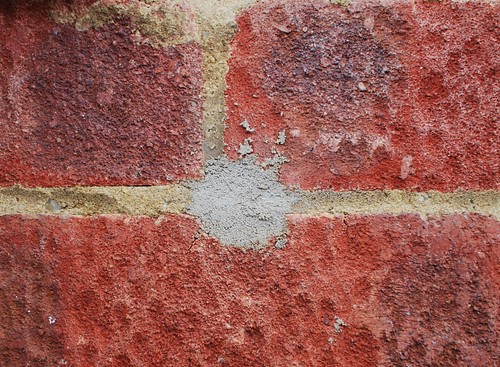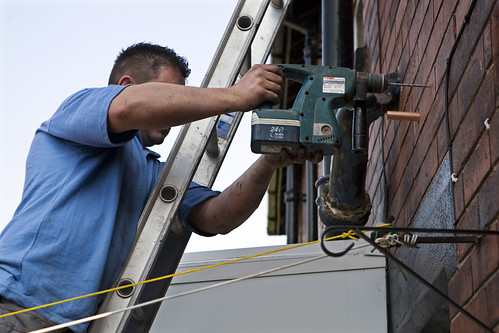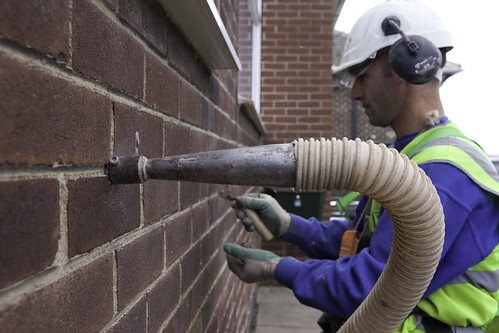
The thermal image above shows heat loss in a row of houses. The house in yellow has cavity wall insulation. In the first in a new series 'Save Energy, Save Money', Mike Pepler explains the basics.
Most houses built since about 1920 have a 'cavity wall', which means there are actually two layers of bricks with a cavity between them.
When this cavity is filled with air, the walls account for about a third of the heat loss from an average house - and that's costing you money when you pay for your energy.
If the cavity is filled with an insulating material, the heat loss can be reduced by up to 70%, saving energy and saving you money - typically £110/year at 2010 prices.
How to tell if you have cavity walls
It's possible to tell what types of wall you have by looking at the pattern of the bricks. The Energy Saving Trust has a page showing you how to do this.
How to tell if your cavity walls are already insulated
Houses built since 1990s should have had their cavity walls insulated when they were built. If your house is older than that, but you don't know if a previous owner insulated the walls, you can tell by looking for places on the outside wall where holes have been drilled and filled with mortar.
If you’re not sure, a free survey by an insulation company will determine whether insulation has been installed
Getting cavity wall insulation installed.
Cavity wall insulation needs to be professionally installed by a company registered with the Cavity Insulation Guarantee Agency. One of the easiest ways to find a reputable installer in your area is to contact your local council, as they will be able to recommend one to you and also help you with grants. Alternatively, you can contact the Energy Saving Trust for advice.
The full cost of cavity wall insulation for a 3-bedroom semi-detached house is about £500, but with the various grants available you should pay no more than £250, and perhaps a lot less. Depending on your age and income, it might even be free! With savings of around £110 a year, the payback is very quick.
The insulation is installed by drilling small holes in outer wall of the house:
and then injecting foam or mineral wool to fill the cavity:
Once the cavity is filled, the holes will be filled with mortar to reseal the wall.
What if you have solid walls?
If you don’t have a cavity wall, there are still ways of insulating the walls. We’ll be writing about these soon, but if you can’t wait, then the Energy Saving Trust has some advice.
When this cavity is filled with air, the walls account for about a third of the heat loss from an average house - and that's costing you money when you pay for your energy.
If the cavity is filled with an insulating material, the heat loss can be reduced by up to 70%, saving energy and saving you money - typically £110/year at 2010 prices.
How to tell if you have cavity walls
It's possible to tell what types of wall you have by looking at the pattern of the bricks. The Energy Saving Trust has a page showing you how to do this.
How to tell if your cavity walls are already insulated
Houses built since 1990s should have had their cavity walls insulated when they were built. If your house is older than that, but you don't know if a previous owner insulated the walls, you can tell by looking for places on the outside wall where holes have been drilled and filled with mortar.
If you’re not sure, a free survey by an insulation company will determine whether insulation has been installed
Getting cavity wall insulation installed.
Cavity wall insulation needs to be professionally installed by a company registered with the Cavity Insulation Guarantee Agency. One of the easiest ways to find a reputable installer in your area is to contact your local council, as they will be able to recommend one to you and also help you with grants. Alternatively, you can contact the Energy Saving Trust for advice.
The full cost of cavity wall insulation for a 3-bedroom semi-detached house is about £500, but with the various grants available you should pay no more than £250, and perhaps a lot less. Depending on your age and income, it might even be free! With savings of around £110 a year, the payback is very quick.
The insulation is installed by drilling small holes in outer wall of the house:
and then injecting foam or mineral wool to fill the cavity:
Once the cavity is filled, the holes will be filled with mortar to reseal the wall.
What if you have solid walls?
If you don’t have a cavity wall, there are still ways of insulating the walls. We’ll be writing about these soon, but if you can’t wait, then the Energy Saving Trust has some advice.






2 comments:
Looking forward to your guide on insulation for non cavity wall properties. This time of year I get bad condensation build up as the walls are so cold.
Hopefully we won't keep you waiting too long! Maybe you'll be able to get something installed before next winter - I expect it's a bit later for this winter...
Post a Comment